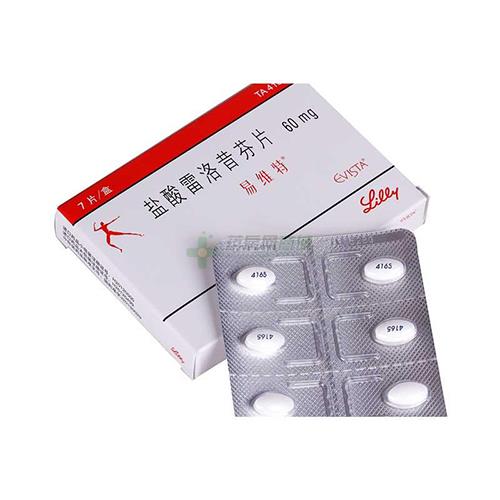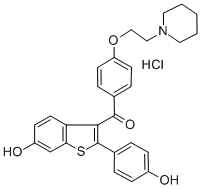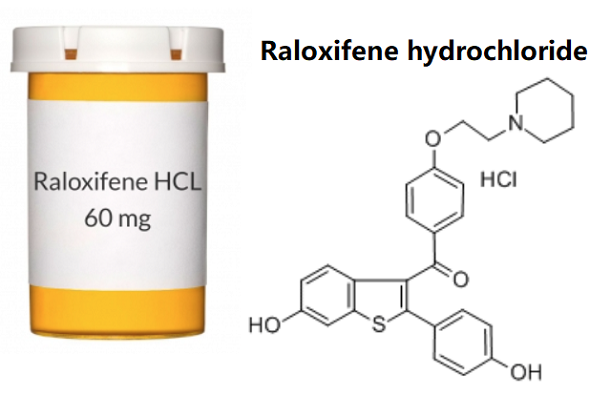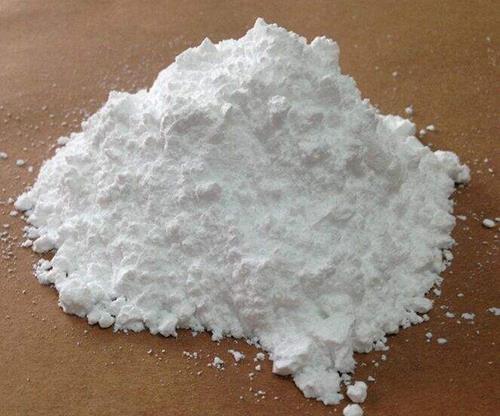The important application of raloxifene
Introduction
Raloxifene is a selective estrogen-receptor modulator (SERM) that has been approved for use in the prevention and treatment of osteoporosis in postmenopausal women. A SERM interacts with estrogen receptors, functioning as an agonist in some tissues and an antagonist in other tissues. Because of their unique pharmacologic properties, these agents can achieve the desired effects of estrogen without the possible stimulatory effects on the breasts or uterus. Raloxifene is rapidly absorbed from the gastrointestinal tract and undergoes extensive first-pass glucuronidation. Approximately 60% of a dose is absorbed; however, absolute bioavailability is only 2%. The volume of distribution is 2348 L/kg for a single oral dose of 30-150 mg, and the elimination half-life averages 32.5 hours. In clinical trials in postmenopausal women, raloxifene had an estrogen-like effect on bone turnover and increased bone mineral density. It reduced the risk of fractures in women with osteoporosis.
Raloxifene also seemed to reduce the risk of breast cancer and positively influenced blood lipid markers of cardiovascular disease. Raloxifene is generally well tolerated; the most common adverse effects are hot flashes and leg cramps. A serious adverse effect is venous thromboembolism. The recommended dosage is 60 mg/day orally without regard to meals. Ultimately, it will be information on cardiovascular or breast cancer benefits that will determine the future role of raloxifene. Raloxifene is an alternative to traditional hormone replacement therapy for the prevention and treatment of osteoporosis in selected postmenopausal women. More study is needed to verify possible benefits related to heart disease and breast cancer.
Application
Raloxifene has been shown to have beneficial effects in selected organs in postmenopausal women. Although estrogen remains the drug of choice for hormonal therapy in most postmenopausal women, raloxifene may be an alternative in certain groups of women at risk for osteoporosis[2].

Picture 1 Raloxifene tablets
Cardiovascular disease and osteoporosis are major causes of illness and death in postmenopausal women. Several observational studies have demonstrated the protective effects of hormone replacement therapy on total mortality rates, cardiovascular mortality rates, and the incidence of osteoporotic fractures in postmenopausal women. However, long-term estrogen replacement therapy is limited by side effects, which can include breast tenderness, vaginal bleeding, mood fluctuations, and thromboembolism. An increased risk for endometrial cancer with unopposed estrogen therapy and the controversy surrounding breast cancer and estrogen treatment both play a role in reducing patient compliance. Thus, a therapeutic agent that has estrogen-agonistic effects on the skeleton and cardiovascular system and estrogen-antagonistic activities on the uterus and breast would be highly desirable for postmenopausal women.
Antiestrogens are compounds that were initially found to antagonize the uterotrophic effects of estrogen. They compete with endogenous estrogens for binding to the estrogen receptor, and they block activation. Tamoxifen is a well-known antiestrogen that has long been used as adjuvant therapy for breast cancer. Although considered an antiestrogen, tamoxifen has partial intrinsic agonistic activities that result in preservation of bone mass and reduction of total cholesterol concentrations. Like estrogens, however, tamoxifen can stimulate the endometrium and increase risk for endometrial cancer in postmenopausal women.
Raloxifene is an antiestrogen that was recently approved for the prevention of osteoporosis in postmenopausal women. Clinical data on the effectiveness, benefits, and risks of raloxifene therapy are rapidly accumulating; therefore, we review data published during the past two decades on the clinical effects of raloxifene in women.
Preparation method of raloxifene hydrochloride
The invention discloses a preparation method of raloxifene hydrochloride[3]. The preparation method of the raloxifene hydrochloride comprises the following steps: firstly reacting 4-[2-(1-piperidyl) ethyoxyl] benzoic acid hydrochloride with 6-methoxy-2-(4-methoxyphenyl) benzothiophene to generate crude raloxifene hydrochloride, refining the crude raloxifene hydrochloride to obtain fine raloxifene hydrochloride. The raloxifene hydrochloride prepared by the preparation method is high in quality and high in purity; the preparation method is simple, low in energy consumption and low in cost.
Reference
1 Kelly R. Snyder, Pharm.D., BCPS, Nicole Sparano, Pharm.D., BCPS, Jennifer M. Malinowski, Pharm.D., Raloxifene hydrochloride, American Journal of Health-System Pharmacy, Volume 57, Issue 18, 15 September 2000, Pages 1669–1675
2 Khovidhunkit W, Shoback D M. Clinical effects of raloxifene hydrochloride in women[J]. Annals of internal medicine, 1999, 130(5): 431-439.
3 CN104496963A Preparation method of raloxifene hydrochloride
Related articles And Qustion
See also
Lastest Price from Raloxifene hydrochloride manufacturers

US $10.00-20.00/kg2025-06-10
- CAS:
- 82640-04-8
- Min. Order:
- 1kg
- Purity:
- 99.8% HPLC
- Supply Ability:
- 20000kg/month

US $5.00-0.50/KG2025-05-07
- CAS:
- 82640-04-8
- Min. Order:
- 1KG
- Purity:
- 99% hplc
- Supply Ability:
- 500TONS



